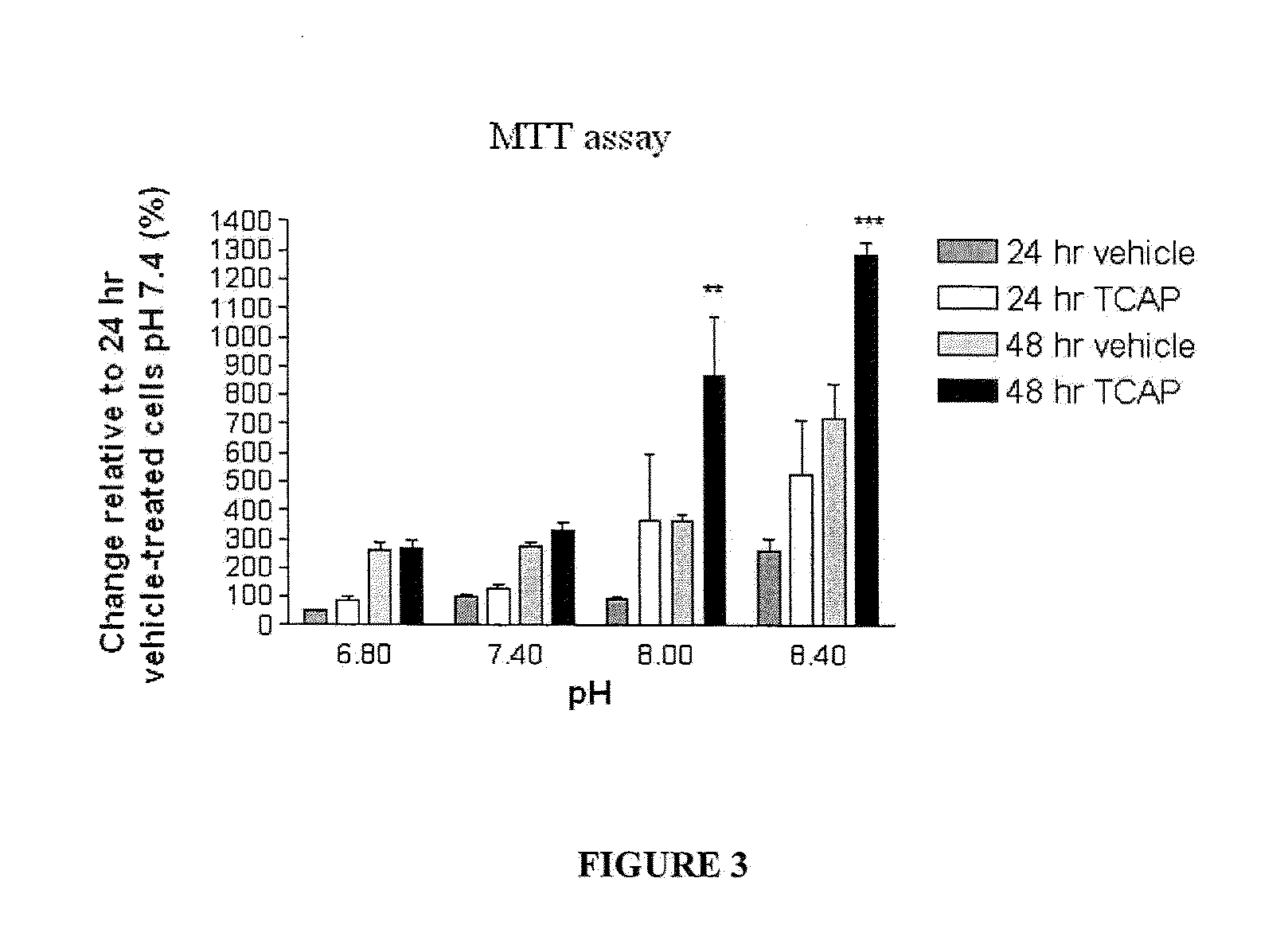Method for Regulating Neurite Growth
a neurite growth and growth technology, applied in the field of neurite growth regulation, can solve the problems of large literature on brain acidosis, ambiguity surrounding cell death, cell death, etc., and achieve the effects of increasing optical density, reducing total cell number, and decreasing the number of cells
- Summary
- Abstract
- Description
- Claims
- Application Information
AI Technical Summary
Benefits of technology
Problems solved by technology
Method used
Image
Examples
example 1
Peptide Synthesis
[0096]Mouse TCAP-1 (i.e., SEQ. ID. NO. 38) was prepared by solid phase synthesis as previously described (Qian et al., 2004). The peptide was solubilized in phosphate buffered saline (PBS) at a concentration of 2×10−7 M before being diluted in the appropriate medium.
[0097]More particularly, a mouse paralogue of the putative peptide sequence from teneurin-1 was synthesized on an automated peptide synthesizer, Model Novayn Crystal (NovaBiochem, UK Ltd., Nottingham, UK) on PEG-PS resin using continuous flow Fmoc chemistry (Calbiochem-Novabiochem Group, San Diego, Calif.). Eight times excess diisopropyl ethylamine (Sigma-Aldrich Canada Ltd.) and four times excess Fmoc-amino acid activated with HATU (O-(7-azabenzotriazol)-1-3,3-tetramethyluronium hexyluorophosphate; Applied Biosystems, Foster City, Calif.) at a 1:1 (mol / mol) ratio were used during the coupling reaction. The reaction time was 1 h. A solution of 20% piperidine (Sigma-Aldrich Canada Ltd.) in N,N-dimethylfor...
example 2
Cell Morphology Analysis
[0098]The effect of TCAP-1 on cell morphology was conducted using the N38 cells immortalized mouse hypothalamic cell line (Belsham et al, 2004). Cells were grown in six-well culture plate with 2 ml of Dulbeco's Modified Eagle Medium (DMEM) with high glucose, L-glutamate, 25 mM HEPES buffer, pyridoxine hydrochloride in the absence of sodium pyruvate, 5 ml penicillin with 10% fetal bovine serum (FBS) at pH 7.4 (all from Gibco-Invitrogen, Burlington, Canada).
[0099]At 24 and 48 hrs, the medium was replaced with medium buffered at pH 6.8, 7.4, 8.0 or 8.4. Half of the cell groups received (10−7M) TCAP-1, whereas the other half received phosphate buffered saline (PBS) pH 7.4 containing 8 g NaCl, 0.2 g KCl, 1.4 g Na2HPO4, 0.2 g KH2PO4 in 800 mL ddH2O. For all groups, 4 replicates were run. Digital pictures were taken at 24, 48 and 72 hrs using an Olympus IX&1 inverted microscope at magnification and analyzed using Lab Works 4.0 Image Acquisition and Analysis Software...
example 3
Effect of TCAP on Cell Proliferation and Viability
[0101]The effect of TCAP-1 on cell proliferation at each pH was examined by direct counts using a hemocytometer and indirectly by assessing mitochondrial activity using a colorimetric MTT (3-[4,5-dimethylthiazol-2-yl]-2,5-diphenyl tetrazolium bromide) assay on cultured N38 cells. For hemocytometer counts, the cultures were incubated for 24 and 48 hrs. The cells were suspended using 1 ml of 0.25% Trypsin with EDTA (Gibco-Invitrogen, Burlington, Canada), centrifuged at 1600 RPM for 4 min, and resuspended with PBS. The cells in 50 μl aliquots were vortexed and counted on a hemocytometer.
[0102]The proportion of viable cells in the samples was determined by measuring Trypan Blue uptake. At 48 hrs, the cells from the four pH treatments were suspended using 1 ml of Trypsin EDTA, centrifuged at 1600 RPM for 4 min and resuspended in 1 ml of BSS (Hank's Balanced Salt Solution) (Sigma, St. Louis). An aliquot of 0.5 ml of 0.04% Trypan Blue solut...
PUM
| Property | Measurement | Unit |
|---|---|---|
| pH | aaaaa | aaaaa |
| pH | aaaaa | aaaaa |
| pH | aaaaa | aaaaa |
Abstract
Description
Claims
Application Information
 Login to View More
Login to View More - R&D
- Intellectual Property
- Life Sciences
- Materials
- Tech Scout
- Unparalleled Data Quality
- Higher Quality Content
- 60% Fewer Hallucinations
Browse by: Latest US Patents, China's latest patents, Technical Efficacy Thesaurus, Application Domain, Technology Topic, Popular Technical Reports.
© 2025 PatSnap. All rights reserved.Legal|Privacy policy|Modern Slavery Act Transparency Statement|Sitemap|About US| Contact US: help@patsnap.com



